President’s account of study tour to waterways in Bohemia and Saxony
The Upper Vltava Waterway, the Saale-Elster Canal and waterways around Leipzig
One of IWI’s activities is tours for its members. Many of you will remember the tours led by founder Ron Oakley for many years. Today the tours have been carried on and are organized by our past president Tom Grasso. In addition, we offer occasional study tours such as the April 2011 tour to Bohemia and Saxony. This was organized by David Edwards-May through Euromapping and involved the local assistance of Tom Kolarlik of the Czech waterways association, Michael Witfer, President of the Saale-Elster Canal association, Merseburg, and Angela Zábojnik, project manager in the parks and open space department of the City of Leipzig, Germany.
I hope to capture some of what was experienced by the over 40 participants. The tour was organized around two significant ongoing waterway projects including exceptional engineering works; first on the Vltava, where navigation will be extended up to the town of České Budějovice by about 2015 (depending on funding). This involves an inclined plane at Orlik dam (see photo) and a lock, tunnel and boat lift at Slapy.
The second major project is the connection of Leipzig to the European waterway network by completion of the Saale-Elster Canal. In advance of this ambitious project, Leipzig has already completed substantial work to open navigable access to most of the new lakes in the former lignite-mining area to the south of the city.
So for this unique opportunity we were guided by the very knowledgeable and enthusiastic Tom Kolarik, Michael Witfer and Angela Zábojnik.
Sunday 3 April
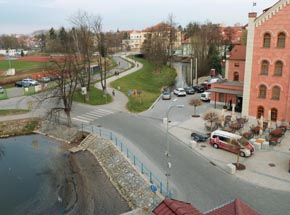
České Budějovice, where a new lock is to be built to give access to the town centre (view from our window in the Klika Hotel)
Most of us were picked up by coach at Prague airport and travelled to České Budějovice where we stayed overnight at the Klika Hotel. The hotel is situated on the waterfront in the town centre beside the site of a projected lock which would allow boats to reach the town centre. This idea has been adopted by the mayor and his deputy mayor for economic development. The mayor came to greet us while having dinner in the hotel that evening.
Monday 4 April
On Monday morning we gathered at a hall close by the hotel and heard from the Deputy Mayor for Strategic Development and Regional Planning, Ivana Popelová about the the city and its project Město a voda (city & water), presentations about the Vltava project by engineer Jan Bukowski of the Ředitelstvi vodnich cest (ŘVC) and a presentation by Tom Kolarik of the Czech waterways association. I completed the speeches with a quick introduction to IWI, what it represents and some examples of recent developments in Europe and North America where there have been or are expected to be great economic spinoffs showing that waterway planning, improvements and building is taking place with success literally around the world.
At the end of the presentations there was a press conference attended by David Edwards-May, Tom Grasso and myself through an interpreter. There were about a 5-6 media representatives there who asked what we thought of the proposals, what did we think of their city and examples of other places where this type of development has happened and seen increased economic development.
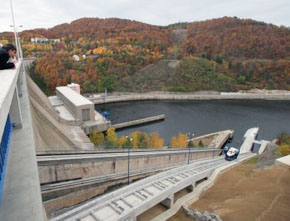
Orlík dam
The press conference was chaired by the Mayor of Hluboká nad Vltavou, who after the press conference decided that he would personally meet and escort us when we came to his town shortly after lunch. In the interim and in the rain we proceeded to the site of the boat moorings on the Vltava at Lannova lodÄ›nice just downstream. Most of us looked at the site from the bus windows as the sky had opened up and it poured rain. We visited the newly built lock and nearby boat harbour at České Vrbné which I must say was well done and certainly the envy of any waterway manager. We all walked the site and those with umbrellas became everyone’s friend. We had lunch here also which turned out to be an indoor picnic so we could dry out and warm up. After lunch we met up with Senator Jirsa, Mayor of Hluboká, who showed us the works started on the lock and also the location where a large marina will be built below the splendid château.
It is interesting to note that Mayor Jirsa is also a member of the Czech Senate in the Parliament of the Czech Republic and sits on the Committee on Foreign Affairs, Defence and Security. It was wonderful to see his interest and enthusiasm for the Waterway works taking place in his community specifically and on Waterways in the Czech Republic generally. By this time the rain had become intermittent and we could enjoy the rest of our day!
We visited the existing Hnevkovice dam and lock, an impressive 20m high structure. Hnevkovice II lock (1500m downstream) will be the last to be built on the Vltava waterway, and work is expected to begin in spring 2012. We continued on to Orlik dam, where the ŘVC engineer Jan Bukowksi presented the project for the ship lift (inclined plane), adapting the abandoned marine lift that was never completed. It is beside the much smaller marine railway that is presently used. The engineers explained what was planned for this site and showed us design drawings featuring the amended cross-section of the trough, the caisson and the counterweights. Using the existing structure is possible, after stripping the badly worn concrete. Then we had a great tour of the power plant including going below the working floor of the turbine room to see the turbines in action, which from my experience is very rare indeed.
So as the day ended we headed for Prague and the Roma Hotel which is on the left bank of the Vltava. It is very close to the Charles Bridge and Smichov lock, one of the busiest in the world, A number of us went across the Charles Bridge and marveled at the lights of the city as they reflected on the water. It is a beautiful city even at night. However, for some of us we had an added experience and expense. Being the independent folks we are, we walked across a busy road against the lights and landed literally in the arms of Prague’s finest. We were being charged with ‘jay walking’ or some such misdemeanor. So we had to pay the fine on the spot. What was interesting is that punishment started off with the threat of going to the police station and spending time in the jail to paying a fine of 2000 Czech koruna down to paying a fine of 100 Czech koruna each. So thanks to Katie Boyd-Wetter’s keen negotiating skills (even after she gave the policeman a bit of her mind), we got off with a 100 Czech koruna fine (23 Czech Koruna = 1 Euro). Some others from the tour also got caught at the same place and they had to pay 500 Czech koruna each. So the moral is you can negotiate pedestrian fines in Prague. This didn’t stop us from having a great evening in Prague.
Tuesday 5 April
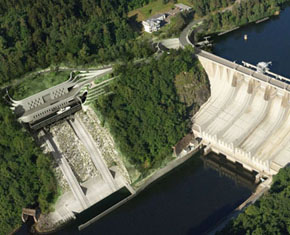
Digital rendering (by RVC) of the scheme finally adopted for Slapy, with the existing lock, bridge, short (two-way) tunnel at upstream level and transverse inclined plane.
The next day we returned up the Vltava valley to visit the other spectacular site, Slapy dam, where engineer Bukowski explained the current project for an entrance lock (upper gate structure existing), a short tunnel and a transverse inclined plane on the right bank side of the 53m high dam! This is a unique combination which has never been implemented anywhere in the world, not even in China! The confidence in getting this built is not outdone by the scope and scale of the project. In fact, at the upper side of the dam is the remnant of an earlier start to this project which was later abandoned.
On our return to Prague we stopped at Štěchovice dam to see the high-capacity lock. The lower gates are very high being over 20m. I am sure that the lockmaster was a bit concerned with all these people climbing around the lock while it was empty. It was quite a drop!. We also got to see the control room with its modern monitor screens and controls along with some of the old equipment.
We were free for lunch in Prague prior to catching our train to Leipzig. It gave us another opportunity to see a bit more of the city in the daytime. We all got the train and made it to Leipzig as a group. We transferred by coach to our hotel the Check Inn, Merseburg.
Wednesday 6 April
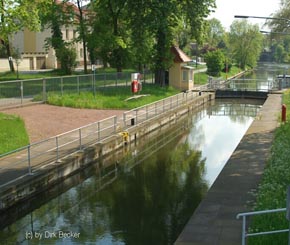
Merseburg-Meuschau lock on the Saale (© Dirk Becker)The unfinished upper lock at Wüsteneutzsch
Meeting for promotion of Saale-Elster Kanal revival
On Wednesday morning many of us walked the short distance from our hotel to the Guildhall. We were able to see the old high capacity canal which the SEK (Saale-Elster-Kanal) association hopes to see restored. We also walked by the Merseburg-Meuschau lock before arriving at the Ständehaus (Guildhall) in the town centre, to promote the completion of the Saale-Elster Kanal from Merseburg to Leipzig. This building and hall were beautifully restored and an appropriate place to meet.
The meeting went on for the morning and into the early afternoon following lunch. There was an excellent turnout of those interested and/or supportive of the subject (over 100 attendees). Again there were a number of speakers including myself on behalf of IWI. Following the presentations, there was a question and answer session with many good questions. David Edwards-May participated in this session to answer the English questions. I should note and commend David Edwards-May and organizers that translation service was provided which made the session much more informative for those of us on the tour who do not understand German. There was a charge to those on the tour, but in my view it was well worth the additional cost. The media covered the event and a number of us did interviews for television and/or radio.
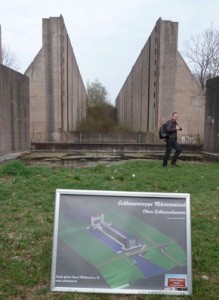
The unfinished upper lock at Wüsteneutzsch
Following the meeting we travelled to the site of the uncompleted lock at Wüsteneutzsch: there were to be two locks overcoming a 22m difference in level, however, the works were abandoned and left uncompleted during WWII. This was really interesting and we all climbed up and around the site to get an idea of its scope and design and how the existing structure fitted in with the other lock that was not built. Events are now held inside the locks during the summer. The project’s promoters would like to see a single lift built at the site (on a route bypassing the historic lock chambers retained as heritage) to make it a visitor attraction in itself (inspired by the Falkirk lift). It was interesting to note the lack of interpretive signage and way signs to guide visitors to the site. Michael and our hosts explained that they were in fact being built as we spoke and would be in place soon.
Thursday 7 April
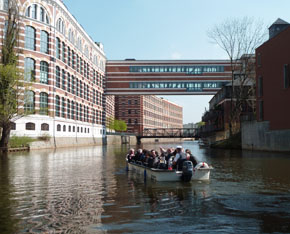
The Elster river was lined by textile factories, which have been rehabilitated to become highly desirable offices; the boat trip courtesy of the Wasserstadt Leipzig revealed many other attractive waterside developments.
Leipzig rivers, canals and new lake district
On Thursday 7 we started our tour at the Lindenauer Harbour, site of the link to be cut with the Karl Heine Kanal. We saw the large old silos which had been built in earlier times to be served by what became an uncompleted canal. From here we travelled to Plagwitz, where we boarded two small open tour boats which took us along the canal where we saw the industrial past which was giving way to the redevelopment of restored factories and the addition of new buildings. The tour boats we were on provide tours during the visitor season. Our boat trip ended at the new harbour built on the Elstermühlgraben where again there are plans for a larger marina site. Presently there is a modern wharf for the use of tour boats and others like canoes and kayaks. Angela Zábojnik, of the Department of Urban Green Areas and Watercourses was our guide and certainly another enthusiast of the work taking place in Leipzig. She led us on a walking tour of the partially restored mill stream and what is planned into the future. It reminded me a bit of Tom Grasso’s Rochester project, but on a much smaller scale. Taking the cover off of old canals and rewatering them where needed and completing the network. We walked all the way to the Federal Administrative Court which fronted onto the Pleisse millstream.
We had a lovely lunch at Rathaus (City Hall) where we learned from one of the Deputy Mayors, Haiko Rosenthal, about the City’s plans for its rivers and streams into the future and the rationale behind these wonderful initiatives. Following our visit to the Rathaus we travelled to the New Lake District for a tour of the area which was formerly a series of open-cast lignite mines south of Leipzig which were being turned into lakes and recreational areas. The area includes preserved forests, new canals and locks linking the various lakes and new facilities such as beaches, marinas, sailing centres and a state of the art kayaking and white water centre at Markkleeberg which we visited and saw some of the national kayaking team practising.
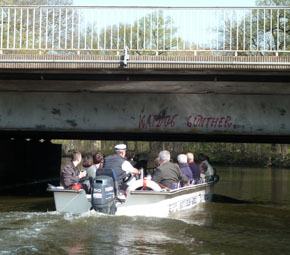
Many low bridges in Leipzig prevent through navigation to all but the smallest craft; bridges will be raised to offer 1.90m headroom as and when they need to be rebuilt or in lieu of major rehabilitation.
As part of our visit we visited a viewpoint and a visitor centre at Zwenkauer See and saw and heard about the redevelopment and flooding of the lakes from a representative of the open mining company. This proved to be very interesting and the whole idea of making lakes out of mines is unique for me.
We also visited Zwenkau where they are building a marina prior to flooding the mined area. It is somewhat bizarre to see this beautiful marina and harbor which is presently landlocked. We ended our tour at Cospudener See at a restaurant by the lake where we had a lovely dinner before returning to our hotel in Merseburg.
Friday 8 April
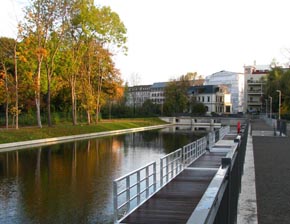
New harbour built on the Elstermühlgraben
On Friday we met up with our tour leader Mr. Werner of the City of Leipzig Department of Urban Green Areas and Watercourses at the Cospuden Lock and he talked to us about the lock which was completed in 2006 and is certainly state-of-the-art technology. From here we went to see the Connewitz Lock which is just being finished and again state-of-the-art. It also includes a fish ladder which can be used by kayakers apparently. Everything at these locks we saw was first class and high quality.
Following our goodbyes to Mr. Werner and our translator Katya we headed for Leipzig station where the tour ended and we said our goodbyes. At this point everyone was starting on their way home via a number of German cities or back through Prague.
One thing I do want to mention was the fact we had translation facilities as I previously mentioned. In addition we had a translator accompany us during the times we were on tour for the two days in and around Liepzig. Again I think this added so much value to the tour and allowed those of us not familiar with German to fully understand and appreciate what we were seeing and experiencing.

A windy April evening on the Cospudenersee tempted kitesurfers out on to the water, where the tour had its last dinner at the nearby Seeterrasse restaurant. A remarkable environment has been created from the ashes of the former lignite mine.
My thanks to all involved
In summation, I really enjoyed meeting so many members of IWI and others, many for the first time along with renewing old friendships. I enjoyed seeing the waterways, initiatives and developments that I have either read or heard about from others. To see what is planned and happening certainly shows that waterways and canals are alive and well. I hope you will consider being a part of the next tour. Also thank you to those who participated and to David Edwards-May and Sylvain Blanchard of Euromapping and our hosts, tour leaders, guides and speakers who I have previously mentioned. Thank you for making this a success.
Dave Ballinger
April 2011
